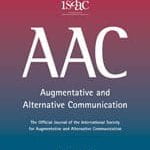The goals of this paper are two-fold: (a) to summarize the research related to AAC systems for young children, and (b) to define priorities for future research to improve AAC technologies and enhance outcomes for children with complex communication needs.
Penn State AAC community welcomes UNL scholar
Collaborating with AAC-RERC partner to advance research in AAC for adults with aphasia
Now Available: A Comparison of Using Iconic Encoding In AAC Systems With and Without Iconic Prediction — Publication
Results of this comparison study indicated that the children in the iconic prediction group did not perform more accurately than the children who did not have prediction available. There was some evidence, however, that using iconic prediction may help to facilitate generalization of use of iconic encoding to novel vocabulary.
Improving literacy outcomes for individuals with autism spectrum disorders and limited speech – Webcast
This free webcast provides information on effective instructional procedures to teach literacy skills to individuals with ASD and limited speech. The webcast includes both detailed instructional procedures, as well as case examples (including videoclips) of reading and writing instruction with children and adolescents with ASD.The webcast provides information on how to teach key literacy skills, including phonological awareness skills, […]
Introduction to the use of AAC for children with complex communication needs – Webcast
This introductory level webcast on “AAC and Children” (20 minutes) by Kathy Drager, Janice Light, and David McNaughton (Penn State University) is designed as an introduction to the use of AAC. It focuses on ways to provide communication opportunities, model the use of AAC, pause, respond to the child, and most of all, to have […]
- « Previous Page
- 1
- …
- 67
- 68
- 69
- 70
- 71
- …
- 76
- Next Page »


